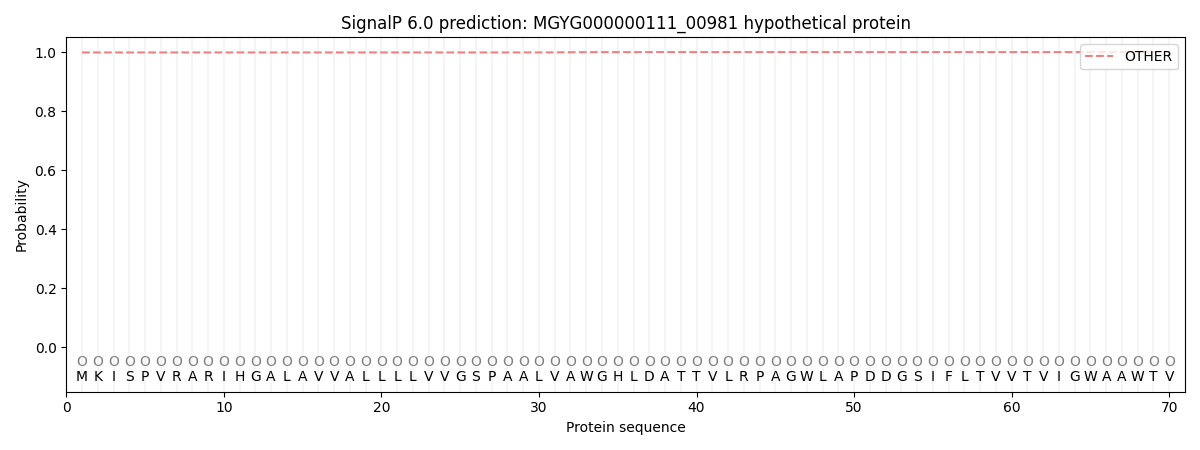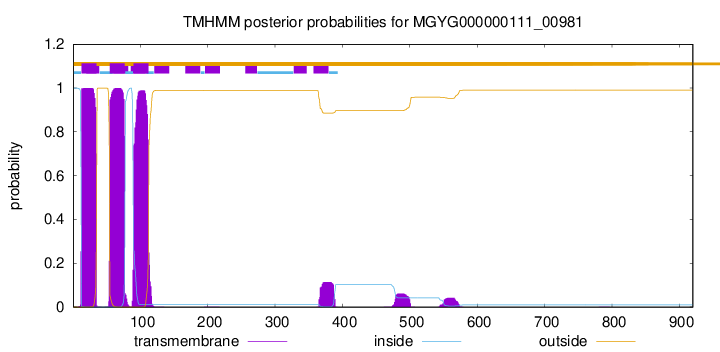You are browsing environment: HUMAN GUT
CAZyme Information: MGYG000000111_00981
You are here: Home > Sequence: MGYG000000111_00981
Basic Information |
Genomic context |
Full Sequence |
Enzyme annotations |
CAZy signature domains |
CDD domains |
CAZyme hits |
PDB hits |
Swiss-Prot hits |
SignalP and Lipop annotations |
TMHMM annotations
Basic Information help
| Species | Cutibacterium acnes | |||||||||||
|---|---|---|---|---|---|---|---|---|---|---|---|---|
| Lineage | Bacteria; Actinobacteriota; Actinomycetia; Propionibacteriales; Propionibacteriaceae; Cutibacterium; Cutibacterium acnes | |||||||||||
| CAZyme ID | MGYG000000111_00981 | |||||||||||
| CAZy Family | CBM50 | |||||||||||
| CAZyme Description | hypothetical protein | |||||||||||
| CAZyme Property |
|
|||||||||||
| Genome Property |
|
|||||||||||
| Gene Location | Start: 144595; End: 147357 Strand: + | |||||||||||
CDD Domains download full data without filtering help
| Cdd ID | Domain | E-Value | qStart | qEnd | sStart | sEnd | Domain Description |
|---|---|---|---|---|---|---|---|
| PRK11198 | PRK11198 | 7.30e-10 | 215 | 289 | 78 | 147 | LysM domain/BON superfamily protein; Provisional |
| smart01043 | BTAD | 1.18e-07 | 773 | 911 | 2 | 145 | Bacterial transcriptional activator domain. Found in the DNRI/REDD/AFSR family of regulators. This region of AFSR along with the C terminal region is capable of independently directing actinorhodin production. This family contains TPR repeats. |
| cd00118 | LysM | 3.31e-06 | 156 | 202 | 2 | 45 | Lysin Motif is a small domain involved in binding peptidoglycan. LysM, a small globular domain with approximately 40 amino acids, is a widespread protein module involved in binding peptidoglycan in bacteria and chitin in eukaryotes. The domain was originally identified in enzymes that degrade bacterial cell walls, but proteins involved in many other biological functions also contain this domain. It has been reported that the LysM domain functions as a signal for specific plant-bacteria recognition in bacterial pathogenesis. Many of these enzymes are modular and are composed of catalytic units linked to one or several repeats of LysM domains. LysM domains are found in bacteria and eukaryotes. |
| cd00118 | LysM | 1.64e-05 | 238 | 287 | 1 | 45 | Lysin Motif is a small domain involved in binding peptidoglycan. LysM, a small globular domain with approximately 40 amino acids, is a widespread protein module involved in binding peptidoglycan in bacteria and chitin in eukaryotes. The domain was originally identified in enzymes that degrade bacterial cell walls, but proteins involved in many other biological functions also contain this domain. It has been reported that the LysM domain functions as a signal for specific plant-bacteria recognition in bacterial pathogenesis. Many of these enzymes are modular and are composed of catalytic units linked to one or several repeats of LysM domains. LysM domains are found in bacteria and eukaryotes. |
| pfam01476 | LysM | 3.61e-05 | 240 | 288 | 1 | 43 | LysM domain. The LysM (lysin motif) domain is about 40 residues long. It is found in a variety of enzymes involved in bacterial cell wall degradation. This domain may have a general peptidoglycan binding function. The structure of this domain is known. |
CAZyme Hits help
| Hit ID | E-Value | Query Start | Query End | Hit Start | Hit End |
|---|---|---|---|---|---|
| ALD68825.1 | 0.0 | 1 | 920 | 1 | 920 |
| BBJ76899.1 | 0.0 | 1 | 920 | 1 | 920 |
| AID35057.1 | 0.0 | 1 | 920 | 1 | 920 |
| QAZ47705.1 | 0.0 | 1 | 920 | 1 | 920 |
| AXM07036.1 | 0.0 | 1 | 920 | 1 | 920 |
Swiss-Prot Hits download full data without filtering help
| Hit ID | E-Value | Query Start | Query End | Hit Start | Hit End | Description |
|---|---|---|---|---|---|---|
| P9WM38 | 1.51e-06 | 154 | 287 | 2 | 152 | Esterase MT1326 OS=Mycobacterium tuberculosis (strain CDC 1551 / Oshkosh) OX=83331 GN=MT1326 PE=3 SV=1 |
| P9WM39 | 1.51e-06 | 154 | 287 | 2 | 152 | Esterase Rv1288 OS=Mycobacterium tuberculosis (strain ATCC 25618 / H37Rv) OX=83332 GN=Rv1288 PE=1 SV=1 |
SignalP and Lipop Annotations help
This protein is predicted as OTHER

| Other | SP_Sec_SPI | LIPO_Sec_SPII | TAT_Tat_SPI | TATLIP_Sec_SPII | PILIN_Sec_SPIII |
|---|---|---|---|---|---|
| 0.999085 | 0.000928 | 0.000000 | 0.000000 | 0.000000 | 0.000000 |

